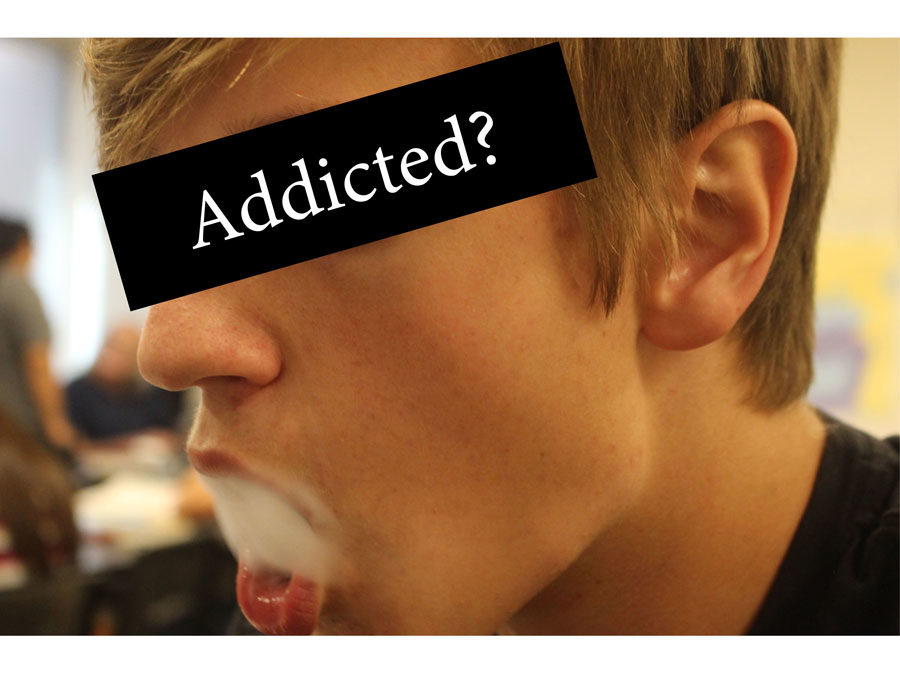Vaping: The Unseen Epidemic
October 2, 2018
The extent of e-cigarette use at Santa Fe High appears to be much larger than teachers and staff think. Small, portable nicotine delivery devices are found in the hands and pockets of students in all grades, all across the school.
“I’d say that the vast majority of my friends will hit a vape if someone offers it,” said one senior. “Half of my friends own one.”
In New Mexico, people have to be at least 18 years old to purchase any vape related products. The price of vapes ranges from as little as $10 to hundreds, meaning that vaping is as affordable as the user wants it to be.
So how does an underage kid end up with a vape? One Santa Fe High student, Daniel Lowery, explained that “some kids will give money to a person that’s over 18, but some stores will sell directly to the underage kid. That’s how many vape shops stay in business.”
“Many students are in blatant disregard of the Code of Conduct,” said Stan Mascarenas, dean of students. During the 2017-2018 school year, Mr. Mascarenas recorded 28 e-cig cases and 41 cases of tobacco use on campus. He recalls that when parents were called, many were outraged, adding that most parents are completely unaware of their child’s nicotine use. “Some parents come pick the e-cig up, but most have them destroyed,” he said.
However, administration doesn’t seem to realize the full extent of e-cig use. In an informal class survey, out of 20 students, 18 said they had friends who vape at school.
Because vaping is a relatively new phenomenon, the health hazards are pretty unknown. A study published on the website of the journal Pediatrics found frighteningly increased levels of carcinogenic compounds in the urine of kids who vape. Certain vape products contain the chemical diacetyl, which is linked to extensive lung damage. For the time being, contents of vape products are “research chemicals,” meaning scientists don’t have a clear idea of the health risks. This makes an entire generation of teens guinea pigs.
The nicotine in vapes is packed in e-liquid, or “juice.” The two types of nicotine found in juice are “freebase” and “salt nicotine.” Freebase liquid is made for those who want big clouds and strong flavor, whereas salt nicotine is for those who just want the nicotine. Salt nicotine is stronger and delivers a more intense buzz; it can only be vaped out of smaller devices with weaker batteries. This means that the little e-cigs that so many students use daily are likely to have high amounts of nicotine.
The nicotine strength in both juices vary, from 0 to 50 percent. They also come in a variety of flavors, such as blue raspberry. The most popular brands have fun, enticing names, like “Mr. Salt – E” and “Vapor Chef.” All juice products are required to have warnings about nicotine addiction, but kids might be more concerned with what flavor they are trying than what habits they are buying.
E-cig juices have an aroma and taste that is more akin to dessert or fruit than carbon monoxide and tobacco. This is dangerous because often it is the flavor of the juice that draws kids in, but it is always the nicotine that keeps them hooked.
One of the most popular e-cigarette brands, Juul, is under heavy investigation by the FDA, according to The New York Times. Nearly one in five students nationwide report that they have seen a Juul or other device being used in school, according to surveys taken by “truthinitiative.org.” According to Truth Initiative, vaping has become a common demon in high schools and middle schools alike. School administrations are scared because their efforts don’t seem to be making a dent in the problem.
So once a kid does get hooked, is there any support at this school for how to quit? “Administration appears not to realize that taking away a student’s device doesn’t take away their addiction,” said one student.
An anonymous senior who vaped high amounts of nicotine every day for a year reported his process of quitting. He described tremendous withdrawal symptoms, such as anxiety, intense cravings and even vomiting. However, these effects lasted only three days. After that, it got easier. After two weeks, he had about two cravings for nicotine a day, and they only lasted around three minutes. He described feeling better and better each day, and feeling more like himself. “Being free of the grasp of nicotine addiction is worth the pain of quitting,” he said.
When students are caught with any kind of smoking device in school, they are offered a six-day anti-smoking program, given as a disciplinary precaution. However, this class is optional. To take the class, students need their parent’s permission. It is therefore fairly easy for a kid to simply not even ask their parents.
A student who attended the class two separate times said, “It didn’t teach me anything. I was on my phone the whole time, and they didn’t even notice.”
E-cigarettes are protected at SFHS by their absolute glorification. Students trying to fit in might find themselves addicted to nicotine for years.
It’s 2018, and kids are still getting addicted to nicotine for fun. The question is, what can reverse this trend?



Gale Hanson • Oct 25, 2018 at 9:01 pm
It’s amazing how the underage students do not need parental permission to get an abortion, but they need a parent’s signature to attend a six-day anti-smoking program?! WHAT IS WRONG WITH THIS PICTURE???